Playing with Kneecaps
your knee bone's connected to your ...
One of the guiding principles of Ortho-bionomy is to 'move into comfort.'
So as you play
with this, stay well within your comfort zone. Do not move
any body part into discomfort. The reason for this is
that you don't want to alarm your body into defending itself and
you for sure don't want to add to or create damage.
To get started, plunk your palm down on your knee. It can
help to be sitting and have your feet up on a foot stool or
ottoman. If your legs don't come up, leave them
down! and place your hand over your knee. You're going
to very gently be exploring how the kneecap moves.
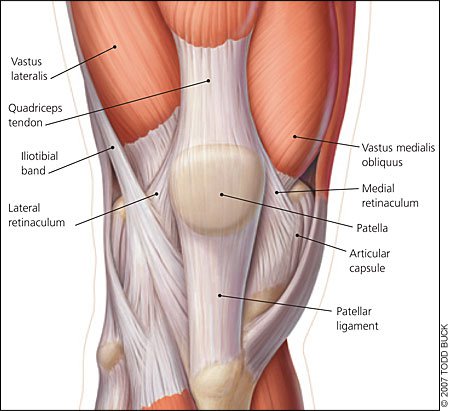 |
For reference
The knee cap is the bony thing on top of
your knee joint. It has some mobility to it. It
can go up/down, left/right, diagonally, rotationally, and
dorsal/ventral. The amount of movement is going to be
explored with the likely result the kneecap will
self-correct to the extent that it can.
It has a lot of things connecting to it. After
this, you may be surprised to find out just how many
things! From this picture you can see tendons
connecting to muscles and ligaments connecting to other
bones. |
| |
|
|
Up/Down Slide
- Check the up/down movement for reference:
- Gently 'drag' your hand across your kneecap up
towards your thigh, suggesting to your knee cap to
move in that direction, and notice how far your
kneecap can comfortably move.
- Gently 'drag' your hand across your kneecap down
towards your shin, suggesting to your knee cap to
move in that direction, and notice how far your
kneecap can comfortably move that way.
- If it does not want to move in one or both
directions, do not make it
move. You may be aware in your mind of a
preference and you can use that instead of an actual
movement, or you can go on to the next set of
directions to explore.
|
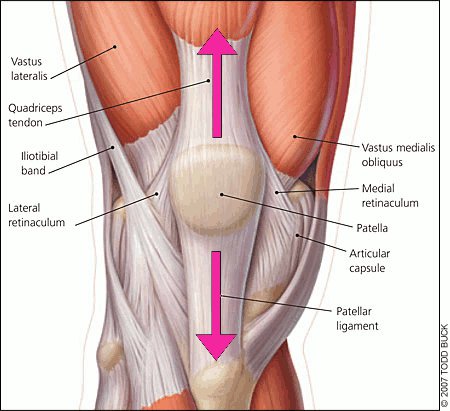
|
- Which ever direction has the greatest comfort, usually
also the greatest movement but not always, move in that
direction finding the greatest comfort. This could
be as little as 1/32 of an inch, or it may be an 1/16 of
an inch.
- Start counting to 60 - you're counting out a
minute.
- Sometime before you get to 60, your kneecap will most
likely start to travel, of its own accord, back to
'neutral. If it doesn't, your done when you
hit 60 in any event.
- Check the up/down movement again:
- Gently 'drag' your hand across your kneecap up
towards your thigh, suggesting to your knee cap to
move in that direction, and notice how far your
kneecap can comfortably move.
- Gently 'drag' your hand across your kneecap down
towards your shin, suggesting to your knee cap to
move in that direction, and notice how far your
kneecap can comfortably move.
- Chances are there is a more even amount of comfort and
movement. If your kneecap was too loose, there
will be less movement in it and that will be a good
thing. If it was too tight, there may be more
movement and that will be a good thing.
- You can do the up/down direction again one more time
if you like.
|
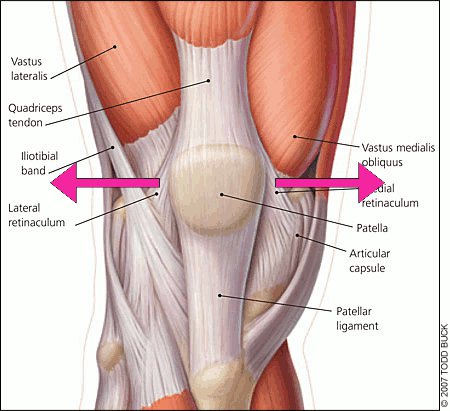 |
Side to Side Slide
- Check the side to side movement for reference:
- Gently 'drag' your hand across your kneecap to the
inside of your leg towards your other knee, suggesting to your knee cap to
move in that direction, and notice how far your
kneecap can comfortably move.
- Gently 'drag' your hand across your kneecap to the
outside away from your other knee, suggesting to your knee cap to
move in that direction, and notice how far your
kneecap can comfortably move that way.
- If it does not want to move in one or both
directions, do not make it move.
You may be aware in your mind of a preference and
you can use that instead of an actual movement, or
you can go on to the next set of directions to explore.
|
- Which ever direction has the greatest comfort, usually
also the greatest movement but not always, move in that
direction finding the greatest comfort. This could
be as little as 1/32 of an inch, or it may be an 1/16 of
an inch.
- Start counting to 60 - you're counting out a
minute.
- Sometime before you get to 60, your kneecap will most
likely start to travel, of its own accord, back to
'neutral. If it doesn't, your done when you
hit 60 in any event.
- Check the up/down movement again:
- Gently 'drag' your hand across your kneecap to the
inside of your leg
towards your other knee, suggesting to your knee cap to
move in that direction, and notice how far your
kneecap can comfortably move.
- Gently 'drag' your hand across your kneecap to the
outside away from your other knee, suggesting to your knee cap to
move in that direction, and notice how far your
kneecap can comfortably move.
- Chances are there is a more even amount of comfort and
movement. If your kneecap was too loose, there
will be less movement in it and that will be a good
thing. If it was too tight, there may be more
movement and that will be a good thing.
- You can do theside-to-side direction again one more time
if you like.
|
|
|
|
Diagonal Slides
- There are 'two' diagonals: up-out / down-in and up-in
/ down-out. It doesn't matter which you start
with, but since I have the up-out picture on top, I'll
use that first.
- Gently 'drag' your hand across your kneecap to the
outside of your leg and up
towards your outer thigh, suggesting to your knee cap to
move in that direction, and notice how far your
kneecap can comfortably move.
- Gently 'drag' your hand across your kneecap to the
inside of your leg and down away from your other
knee towards your shin, suggesting to your knee cap to
move in that direction, and notice how far your
kneecap can comfortably move.
- If it does not want to move, do not make it
move. You may be aware in your mind of a
preference and you can use that instead of an actual
movement, or you can go on to the next set of
directions to explore.
|
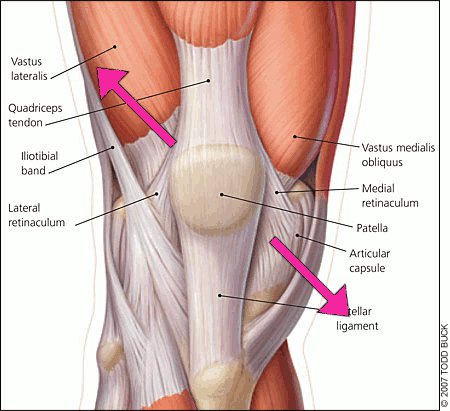
|
- Which ever direction has the greatest comfort, usually
also the greatest movement but not always, move in that
direction finding the greatest comfort. This could
be as little as 1/32 of an inch, or it may be an 1/16 of
an inch.
- Start counting to 60 - you're counting out a
minute.
- Sometime before you get to 60, your kneecap will most
likely start to travel, of its own accord, back to
'neutral. If it doesn't, your done when you
hit 60 in any event.
- Check the up/down movement again:
- Gently 'drag' your hand across your kneecap to the
outside of your leg and up
towards your outer thigh, suggesting to your knee cap to
move in that direction, and notice how far your
kneecap can comfortably move.
- Gently 'drag' your hand across your kneecap to the
inside of your leg and down away from your other
knee towards your shin, suggesting to your knee cap to
move in that direction, and notice how far your
kneecap can comfortably move.
- Chances are there is a more even amount of comfort and
movement. If your kneecap was too loose, there
will be less movement in it and that will be a good
thing. If it was too tight, there may be more
movement and that will be a good thing.
- You can do the same diagonal again one more time
if you like.
|
| You can repeat this with the other diagonal. |
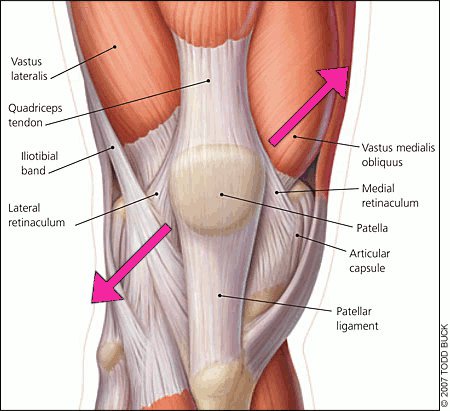
|
|
|
|
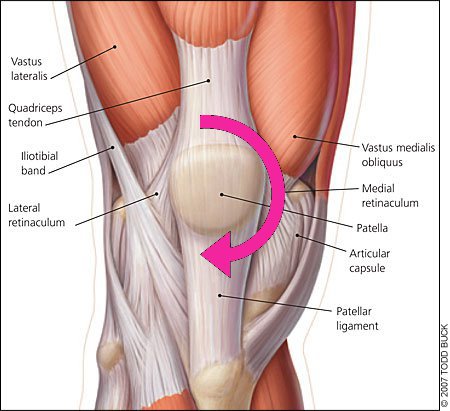 |
Rotations
- You can rotate clockwise and counter-clockwise.
It doesn't matter which you start with.
- Gently 'twist' your hand atop your kneecap as if
your turning a doorknob, suggesting to your knee cap to
move in that direction, and notice how far your
kneecap can comfortably move.
- Gently 'twist' your hand atop your kneecap as if
your turning a doorknob the other way, suggesting to your knee cap to
move in that direction, and notice how far your
kneecap can comfortably move.
- If it does not want to move, do not make it
move. You may be aware in your mind of a preference
and you can use that instead of an actual movement,
or you can go on to the next set of directions to explore.
- Which ever direction has the greatest comfort, usually
also the greatest movement but not always, move in that
direction finding the greatest comfort. This could
be as little as 1/32 of an inch, or it may be an 1/16 of
an inch.
- Start counting to 60 - you're counting out a
minute.
- Sometime before you get to 60, your kneecap will most
likely start to travel, of its own accord, back to
'neutral. If it doesn't, your done when you
hit 60 in any event.
- Check the up/down movement again:
- Gently 'twist' your hand atop your kneecap as if
your turning a doorknob, suggesting to your knee cap to
move in that direction, and notice how far your
kneecap can comfortably move.
- Gently 'twist' your hand atop your kneecap as if
your turning a doorknob the other way, suggesting to your knee cap to
move in that direction, and notice how far your
kneecap can comfortably
move.
- Chances are there is a more even amount of comfort and
movement. If your kneecap was too loose, there
will be less movement in it and that will be a good
thing. If it was too tight, there may be more
movement and that will be a good thing.
- You can do this again one more time
if you like.
|
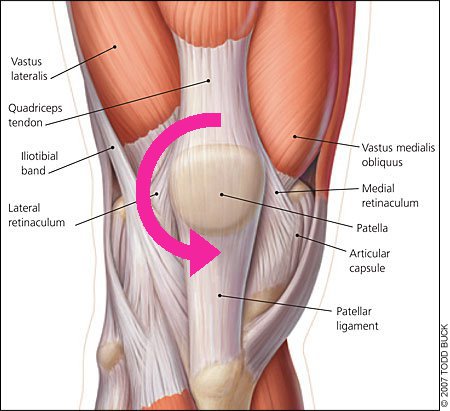 |
|
|
|
Dorsal/Ventral - Teeter totter
- You can also explore the movement in your kneecap by
pressing down and lifting up at opposite ends of an
imaginary teeter-totter. For exmple:
- Gently 'weight' your hand at 3 o'clock (you might
want to use finger tips for this) and lift the
kneecap at 9 o'clock and notice how far your
kneecap can comfortably move.
- Gently 'weight' your hand at 9 o'clock (you might
want to use finger tips for this) and lift the
kneecap at 3 o'clock and notice how far your
kneecap can comfortably move.
- If it does not want to move, do not make it
move. You may be aware in your mind of a
preference and you can use that instead of an actual
movement, or you can go on to the next set of
directions to explore.
- Which ever direction has the greatest comfort, usually
also the greatest movement but not always, move in that
direction finding the greatest comfort. This could
be as little as 1/32 of an inch, or it may be an 1/16 of
an inch.
- Start counting to 60 - you're counting out a
minute.
- Sometime before you get to 60, your kneecap will most
likely start to travel, of its own accord, back to
'neutral. If it doesn't, your done when you
hit 60 in any event.
- Check the same teeter-totter movement again - in this
case:
- Gently 'weight' your hand at 3 o'clock (you might
want to use finger tips for this) and lift the
kneecap at 9 o'clock and notice how far your
kneecap can comfortably move.
- Gently 'weight' your hand at 9 o'clock (you might
want to use finger tips for this) and lift the
kneecap at 3 o'clock and notice how far your
kneecap can comfortably move.
- Chances are there is a more even amount of comfort and
movement. If your kneecap was too loose, there
will be less movement in it and that will be a good
thing. If it was too tight, there may be more
movement and that will be a good thing.
- You can do the same diagonal again one more time
if you like.
You can repeat this with any pairs of opposite dots.
|
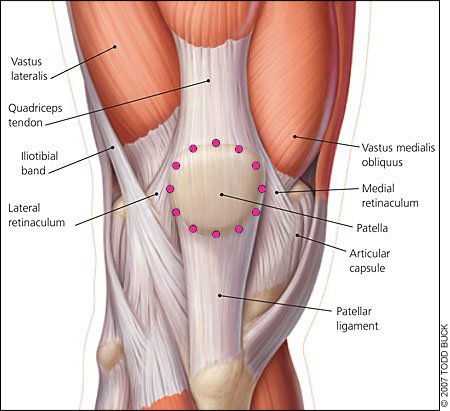 |
|
|
|
| |
|
What do you notice?
Sometimes nothing.
Sometimes there is a cool, tingling sensation. Sometimes
there is pulsing. Sometimes parts of your body nowhere near
your knee will feel better. Chances are, you knee will also
feel better or will move better.
Since there has been a change in your knees, no jumping over
tall buildings today!
You can do both knees every day if you like.
The 'Science'
At first, being a full-blooded American, 'move into comfort' may seem like a
cop-out. What happened to no-pain-no-gain? Well, it's
out the window.
Here's the short version of 'why' this works: If a muscle is
spasming, it's contracting inward on itself, it's getting
smaller. If you pull on it, aka 'stretch,' it will pull
back. This is because the muscle spindles are saying
'DANGER! DANGER!' and will double down with their defense
mechanisms of spasming the muscle more. (The spasm was
originally a defense mechanism and you've now pressed that button
again!) The sensation you
feel is usually called 'pain.'
If you mush the ends of the muscle towards each other, the
muscle spindles, within about a minute, say something (chemically)
like "Gee - I don't have to do this anymore!" and the
contraction goes away.
Seriously.
Your turn!
Do let me know how it goes!
Blessings,
Lynn
Reiki Master since
1997
Certified Resonance Repatterning Practitioner since 1997
4/2/14
[ Back ] [ Home ] [ Next ]
|











